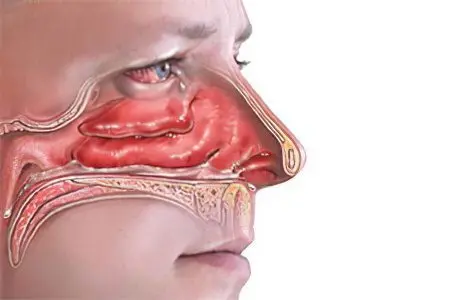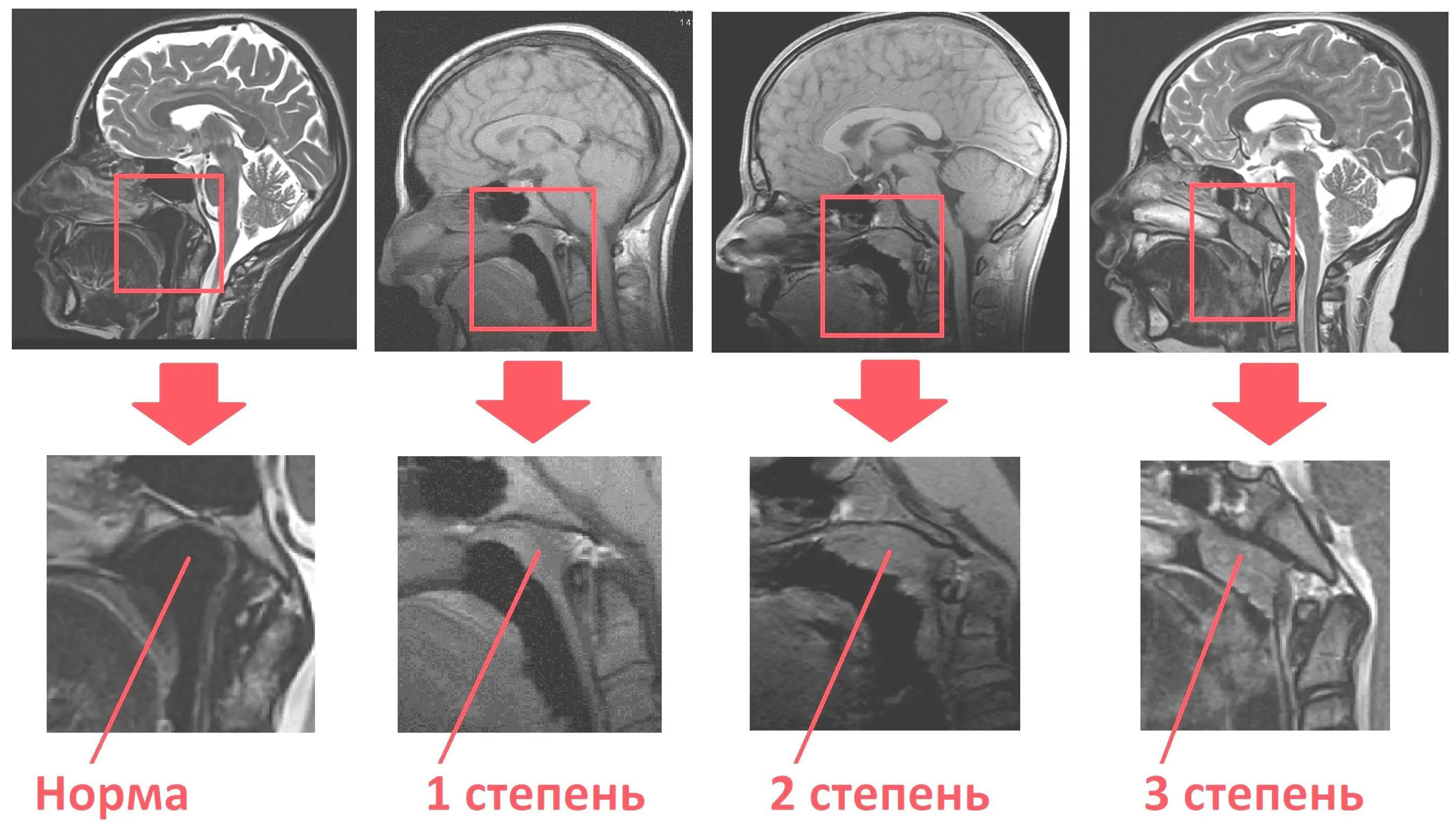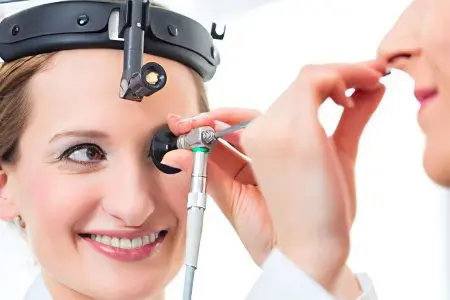Contents
What are adenoids?

Adenoids in the nose – these are areas of pathologically overgrown lymphoid tissue that surrounds the pharynx and nasal part, helps to maintain immunity. When the adenoids grow, they become a constant breeding ground for microbes, fungi and viruses. In this case, the air that enters the nose is not moistened or purified, but immediately ends up in the lower respiratory tract.
The accumulation of lymphoid tissue located in the nasopharynx is designed to prevent their penetration into the deep parts of the human body. The tonsils form a ring, which is called the Waldeyer-Pirogov ring. The nasopharyngeal tonsil is also included in this ring. Its location is the vault of the nasopharynx.
The system of local immune protection in the form of lymphoid tissue of the nasopharyngeal tonsil remains imperfect during the first three years of a child’s life. The level of lgA in nasal secretion in children is lower than in adults. For this reason, children easily get sick, they have protracted colds. By the age of 12, the adenoids begin to decrease in size, and by the age of 16–20 only remnants of the adenoid tissue remain; in adulthood, people most often experience complete atrophy of the adenoids.
Only by the age of 14 will the full formation of local immunity occur. In the future, the pharyngeal tonsils begin to involute, but the lymphoid follicles do not lose their activity until the end of life. Therefore, the problem of adenoids in the nose remains relevant in any age period.
Moreover, in recent years, in practical otolaryngology, hypertrophied adenoids are increasingly being detected precisely in the adult contingent of patients. Experts attribute this, first of all, to the deterioration of the environmental situation in cities. Although most scientists are of the opinion that the increase in cases of detection of adult patients with adenoids is due to an increase in the quality of diagnosis by equipping doctors’ offices with endoscopic equipment that allows them to carefully examine the nasopharyngeal cavity.
I must say that the adenoids grow gradually after suffering diseases such as SARS, influenza, scarlet fever and others.
The nasopharyngeal tonsil is an important organ of human immunological defense, and its growth leads to the appearance of clinical symptoms that worsen the quality of life of patients. Therefore, timely diagnosis and treatment of adenoids in adults is an urgent problem of modern medicine.
Symptoms of adenoids in the nose

Symptom of adenoids is a violation of nasal breathing (when the child sleeps with his mouth open at night), headaches, hearing loss, chronic apathy of the child, after sleep he gets up tired.
The lower part of the mouth sags due to the constant open mouth, over time the shape of the face may change, there is even a name “adenoid face” or “external adenoidism”. At school, such children are teased by their peers, which injures the child. These children have few friends, for this reason, in most cases, they withdraw into themselves. This can greatly affect the future life of the patient in terms of the formation of his character and mental characteristics. If you suspect symptoms of adenoids in a child, immediately seek help from a specialist, because eliminating these manifestations at the initial stage is much easier than fighting the disease when the start of treatment is delayed, with the child developing shortcomings that he will be ashamed of.
Small children with adenoids have a harder time starting to speak; in older children, the voice changes, it becomes less sonorous. There may be a violation of the gastrointestinal tract, anemia may begin to develop, sometimes there is urinary incontinence at night, coughing attacks at night, asthmatic attacks. In acute adenoid, the temperature can rise to 39 ° C and above, there is a burning sensation in the nasopharynx.
Such children suffer from dysfunction of the nervous system. Due to reflex neurosis, some may have enuresis – urinary incontinence. At school, children study poorly, become inattentive, not assiduous at their desks. Patients have a constant runny nose, which is not amenable to conservative treatment, the use of various medications does not give any positive results, the nose does not breathe as required.
Symptoms of adenoids are also considered an incomprehensible sharp cough at night, incomprehensible pain in the ears and their congestion, the nose does not breathe, it is painful to touch the lymph nodes. In young children, this disease worsens and lasts for about one week.
Chronic adenoiditis appears due to the fact that you often suffer from respiratory diseases. For a chronic disease, the course of the disease is characterized by the following signs: a person begins to vomit after eating, mucus along with pus flows down the back walls and causes a sudden cough, inflammation gradually grows to the throat and nose, it becomes difficult to breathe and swallow. X-rays and rhinoscopy are used to detect such a disease.
Symptoms of adenoids in adults are almost identical:
The person suffers from constant nasal congestion.
Mucus is profusely discharged from the nose.
If you open your mouth and look at the back of the pharynx, then you can often see flowing nasal contents, represented by serous exudate. This irritates the mucous membrane of the oropharynx and provokes a prolonged cough.
Profuse nasal discharge irritates the skin in front of the nose and upper lip. It constantly has a red color, thickens, can become covered with cracks.
During sleep, a person snores, breathes through the mouth, as nasal breathing is difficult. This affects the quality of night rest: first of all, it becomes restless. During sleep, attacks of suffocation are possible, since the root of the tongue is able to sink (with oral breathing in a horizontal position).
If the adenoids grow to the third degree, this contributes to a change in voice. He becomes nasty.
As the lymphoid tissue increases in size, it begins to overlap the auditory tubes. This has a negative effect on hearing acuity.
The combination of symptoms such as poor quality sleep and hearing loss makes a person distracted.
The patient begins to suffer more often from colds, as local immunity weakens, the air is not cleaned of dust and microbes, and it is not warm enough. The most common diseases that develop against the background of adenoids are bronchitis, tonsillitis, pharyngitis.
Periodically enlarged adenoid tissue becomes inflamed. At this time, the patient will experience symptoms such as: fever, general weakness, an increase in regional lymph nodes in size.
If the disease is ignored for a long time, then this leads to characteristic changes in appearance. The lower jaw of a person lengthens, becomes narrow, the bite changes. In medicine, there is even such a thing as “adenoid face”. One glance at the patient is enough for a doctor to understand his problem.
Frequent headaches and decreased mental performance are constant companions of enlarged adenoids. The fact is that difficult nasal breathing does not allow the brain to be saturated with oxygen. This negatively affects the working capacity of a person as a whole.
Some patients with adenoids have disorders in the functioning of the digestive system: loss of appetite, episodes of vomiting, diarrhea or constipation. So, in 23,3% of patients, intestinal dysbacteriosis is detected, which is confirmed by bacteriological research methods.
Otitis media (acute and chronic) are also constant companions of adenoids. Their formation is based on the overlap of the pharyngeal mouth of the auditory tube with lymphoid tissue. In the future, this can lead to the development of hearing loss.
Causes of adenoids in the nose

Cause of adenoids any chronic, untreated inflammation in the upper respiratory tract can become. This leads to the fact that the blood begins to stagnate in the lymph and in the nasopharynx. Due to such stagnation, the child’s immune system stops working, since in children it is weak and not yet fully formed.
Nevertheless, there are a number of reasons for the development of adenoids:
Hereditary predisposition. With violations in the structure of the lymphatic and endocrine systems, adenoids begin to grow in a person. This pathology is inherited and can be traced in blood relatives. In addition to the symptoms of adenoids, such people have a decrease in thyroid function, which is expressed by lethargy, edema, a tendency to obesity and an apathetic mood.
Frequent infectious diseases and their inadequate treatment. The more often a person is, the higher the risk that his adenoids will grow. Acute inflammation of the adenoid tissue does not have time to end with a period of reparation and turns into chronic inflammation. The disease can manifest against the background of acute respiratory viral infections, influenza, measles, scarlet fever, diphtheria, etc. It has been established that it is respiratory viruses that lead to the growth of adenoid tissues more often than others.
Allergization of the body. According to different authors, in 21% of cases, adenoids are caused by allergic inflammation.
Infection of the mucous membrane of the nasopharynx with bacteria of the urogenital tract or digestive tract with the development of candidiasis, and later, adenoids of the nasopharynx. Which infectious agent is considered the leading one in terms of the development of adenoids has not yet been established. Modern medicine has identified 93 types of aerobic and 56 anaerobic agents that can be sown in people with adenoid proliferation.
Primary immunodeficiency or immune diathesis (lymphatic, atopic, autoimmune).
Neoplasms of the pharyngeal tonsil.
Passive or active tobacco smoking.
Lack of hardening activities and physical education.
Unfavorable environmental conditions in the place of human residence. In a negative way, the state of the tonsils is affected by the inhalation of polluted and gassed air. This group of reasons for the formation of adenoids can include the excessive use of household chemicals, the presence of plastic toxic products in the apartment, low-quality furniture, etc.
Degrees of adenoids in the nose
There are three degrees of adenoid hypertrophy in the nose:
Adenoids 1st degree characterized by the fact that the child breathes freely during the day, and during sleep, the size of the adenoids increases, thereby preventing the child from breathing freely.
Adenoids 2st degree characterized by shortness of breath around the clock, snoring during sleep, breathing through the mouth.
Adenoids 3st degree characterized by the fact that the adenoid tissue completely or almost completely blocks the flow of air through the nose into the throat, a sick child is always forced to breathe through the oral cavity.
I must say that breathing through the mouth is very dangerous, it can cause chronic tonsillitis, laryngitis, pneumonia, hearing impairment, and in addition, it can lead to a lag – both mental and physical.

Complications and consequences

Adenoids are dangerous not only because they can worsen the patient’s quality of life, but also because of their health complications.
Among them are:
The formation of chronic pathologies of the respiratory system, in particular, rhinitis, sinusitis, tonsillitis, pharyngitis, bronchitis.
Against the background of adenoids, patients often develop chronic otitis media. In the future, the focus of infection can lead to a serious deterioration in hearing and even hearing loss.
Enlarged adenoids are the focus of chronic infection in the body, which negatively affects the state of health in general. The risk of developing rheumatism, myocarditis and other pathologies of the cardiovascular system increases.
The body’s resistance will gradually decrease.
A person with adenoids will suffer from frequent headaches and impaired performance. He is haunted by a paroxysmal cough, the likelihood of developing neuroses and chronic fatigue increases against the background of poor-quality night rest. Therefore, it is not necessary to delay the treatment of adenoids.
Treatment of adenoids in the nose

Treatment is carried out promptly. The operation is prescribed by an ENT doctor, the operation is called adenotomy – this is the removal of adenoids.
Treatment of adenoids without surgical intervention is a complex, but quite solvable task. Modern medicine offers a choice of many drugs, however, all of them must be used in combination. The treatment regimen is made by a doctor, otherwise, it will not give an effect.
Drug treatment. Comprehensive drug treatment involves the following steps:
Cleansing the sinuses from the accumulation of mucus. For this purpose, washing the nasal passages with antiseptic solutions is used.
The use of vasoconstrictor drugs.
The use of immunomodulators and immunostimulants.
If a purulent infection joins, then there is a need to use antibiotics.
Antihistamines are used to relieve allergy symptoms.
Perhaps the passage of laser therapy.
A good effect in a complex treatment regimen is given by inhalation.
The passage of physiotherapy procedures allows you to consolidate the achieved result.
The use of antiseptics. For washing the nasal passages, such preparations based on saline solutions can be used, such as: Aquamaris, Nosol, Humer. It is also possible to use normal saline solution. It has a low cost, but sufficient efficiency. Washing the nose allows you to disinfect the mucous membranes and prevents the infection from spreading to other respiratory organs. Thick exudate liquefies and is much easier to separate from the nose. Irrigate the nasal passages at least three times a day. Treatment should continue until the inflammatory process is completely stopped. Salt solutions have no side effects, they are safe to use at any age.
The use of vasoconstrictor drugs. It should be understood that vasoconstrictor drugs do not affect the course of the disease. They are used only for the purpose of facilitating nasal breathing of the patient. Drugs that can be used to eliminate nasal congestion: Avamys, Otrivin, Nasonex, etc. The number of injections is calculated depending on the age of the patient. Vasoconstrictor drops should not be used for more than three days in a row. Otherwise, addiction may develop. If longer treatment is required, doctors recommend changing the drug. You can use the drops only at bedtime so that nasal congestion does not bother you at night.
The use of immunomodulators. Immunomodulators help to increase the body’s resistance to various infections. Recovery will take place in a shorter time. A doctor should prescribe such drugs. The duration of treatment is 2-3 months, which depends on the stage of development of the adenoids and the general well-being of the patient.
Antibiotic therapy. If the adenoids are complicated by a bacterial infection, the doctor will prescribe antibacterial drugs to the patient. Self-administration of antibiotics is unacceptable, as this increases the risk of developing complications of the disease.
Getting rid of allergies. It has been proven that adenoids are often accompanied by an allergic component. The use of antihistamines can reduce tissue swelling, relieve itching and burning.
Inhalations. Inhalations for adenoids are prescribed dry and wet, but not hot. This procedure allows you to facilitate nasal breathing, moisturize the mucous membrane of the nasal passages, and prevent the mucus from drying out. It is possible to use anti-inflammatory and antiseptic solutions for inhalation. A single procedure will not bring the desired effect. There should be at least 5-10 of them for a person to feel real relief.
Passage of physiotherapy procedures. Physiotherapy treatment brings the recovery time closer and is used as an addition to the main treatment.
The following activities have worked well:
Electrophoresis. This procedure allows you to deliver the drug into the depths of tissues and mucous membranes. With the help of special equipment, the doctor injects antihistamine, anti-inflammatory and antiseptic drugs into the thickness of the tonsils.
UHF This procedure is prescribed in the case when there is an exacerbation of the disease. It is aimed at reducing the severity of pathological symptoms and accelerating recovery.
UV irradiation. The nasal mucosa is exposed to ultraviolet radiation. This contributes to the destruction of pathogenic flora and increases the effectiveness of treatment.
HF. The procedure is based on the impact of high-frequency electromagnetic radiation on the human body. The effect of EHF is an increase in local immunity, the destruction of pathogenic flora in the treatment area.
Laser treatment. The inflamed tissue of the tonsils is treated with a laser, which contributes to a speedy recovery, an increase in local immunity, and a decrease in the volume of overgrown tissue. Sometimes, with the help of a laser, the doctor removes the overgrown tissue of the adenoids. This procedure is associated with minimal risk of complications. The laser instantly coagulates the vessels, preventing bleeding, and also has a disinfecting effect.
If the disease is not started, then it is quite possible to do without surgical intervention, the main thing is to contact an otolaryngologist in a timely manner for help.
Preventive measures

To prevent the development of adenoids, certain preventive measures should be observed, including:
Regular rinsing of the nasal passages. This simple procedure will allow you to wash off the viruses and bacteria that have settled on the mucous membrane, which means preventing the development of inflammation. Nasal lavage should be carried out after visiting crowded places, as well as during epidemiological outbreaks of influenza and SARS. A cheap and effective nasal rinse is saline.
Performing breathing exercises. You can practice hedgehog breathing (rapid shallow breathing), inhaling and exhaling one and the other nostril in turn. This will improve the blood supply to the nasal mucosa, strengthen local immunity, and clear the nasal passages.
Aromatherapy is one of the methods for preventing adenoids. For this purpose, you can inhale the oil of eucalyptus, mint, lavender, juniper, which have a pronounced anti-inflammatory effect.
We must not forget about proper nutrition, maintaining a healthy lifestyle, tempering activities. All these simple recommendations will increase the overall resistance of the body to various infections.
Be sure to follow the rules of personal hygiene and wash your hands often. During outbreaks of infectious diseases, contacts with patients should be minimized and visits to crowded places should be avoided.
In winter and autumn, you need to take vitamin and mineral complexes.
If you follow these simple recommendations, then it is likely that such a problem as adenoids will bypass a person.









